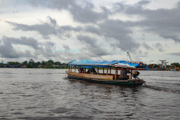The Colombia-Peru Border through the Binational Development Support Operation
DOI:
https://doi.org/10.18667/cienciaypoderaereo.711Keywords:
Colombia, Peru, international cooperation, development, border, securityAbstract
This paper presents a qualitative study, under an analytical and inductive approach, of the implications, in terms of security and development, of the Binational Development Support Operation on the Colombia-Peru border during 2007-2019. To do this, the most representative actions in the execution of said operation were specified, in addition to determining the evolution of the quality of life in this area, based on the concept of the development derived from the operation. The scope and fulfillment of the goals and objectives proposed by the Colombia-Peru Binational Development Support Operation were also addressed in this study. This analysis established, on the one hand, the importance of strengthening this kind of operations in the border area studied, and others with similar characteristics, in order to promote territorial development together with local inhabitants. On the other hand, findings point to the need of engaging more public and private institutions and foreign governments in the construction of international cooperation scenarios for the benefit of development and security, in this particular case, of the riparian zone of rivers Putumayo and Amazonas, bordering territories between Colombia and Peru.
Downloads
References
Álvarez, J. M., & Guerra-Barón, A. (2013). Acuerdo de Asociación Colombia y Perú-Unión Europea: de negociación bloquea bloque a negociación multi-partes. Diálogos de Saberes, (38), 117-132. https://revistas.unilibre.edu.co/index.php/dialogos/article/view/1824/1358
Arciniegas, H. (2018). La integración y el desarrollo fronterizo en la Comunidad Andina. Reflexiones sobre su origen y evolución. Aldea Mundo, (45), 23-35. https://www.redalyc.org/jatsRepo/543/54356888003/html/index.html
Armada de Colombia (2019, 22 de julio). Culminó con éxito la actividad de bienestar más importante de la Amazonía colombiana. Armada de Colombia. https://www.armada.mil.co/es/content/culmino-con-exito-actividad-bienestar-mas-importante-amazonia-colombiana
Ávila Sánchez, V. C. (2017, enero-junio). La guerra entre Colombia y Perú (1932-1934). Una perspectiva desde la prensa venezolana. Tiempo y Espacio, 35(67), 151-175. https://dialnet.unirioja.es/servlet/articulo?codigo=6175402
Cancillería de Colombia (2019, 17 de mayo). Inició la jornada binacional Colombia-Perú. Cancillería de Colombia. https://www.cancilleria.gov.co/newsroom/news/inicio-jornada-binacional-colombia-peru
Cancillería de Colombia (2021a). Plan de Acción para la seguridad fronteriza entre el Ministerio de Defensa Nacional de Colombia y los Ministerios de Defensa y del Interior del Perú. Bogotá: Ministerio de Relaciones Exteriores de Colombia. https://www.cancilleria.gov.co/sites/default/files/Normograma/docs/pdf/plan_seguridadfronteriza.pdf
Cancillería de Colombia (2021b, 19 de marzo). Frontera Terrestre Colombia-Perú. Cancillería de Colombia. https://www.cancilleria.gov.co/frontera-terrestre-colombia-peru
Cancillería de Colombia (2021c, 22 de marzo). Seguridad y Defensa. Cancillería de Colombia. https://www.cancilleria.gov.co/en/integracion-fronteriza-brasil-ecuador-y-peru
Departamento de Acción Integral Fuerza Naval del Sur (2019). Estadísticas generales Operación Binacional Colombia-Perú, 2007-2019. https://www.armada.mil.co/sites/default/files/informe_de_gestion_arc_-_2019.pdf
Equipo de Modelación y Niveles de Referencia Sistema de Monitoreo de Bosques y Carbono (2018). Caracterización de las principales causas y agentes de la deforestación a nivel nacional 2005-2015. fao, masd, & ideam. http://documentacion.ideam.gov.co/openbiblio/bvirtual/023780/Caracterizacion.pdf
Fuerza Aérea Colombiana (2021, 19 de marzo). El conflicto fronterizo. Fuerza Aérea Colombiana. https://www.fac.mil.co/v-el-conflicto-fronterizo
García Pinzón, V. (2018). Dimensiones locales de la seguridad y la cooperación transfronteriza en la frontera amazónica de Brasil, Colombia y Perú. OPERA, (23), 59-80. https://doi.org/10.18601/16578651.n23.05
González-Cuenca, D., & Rodríguez, E. (2018). Desarrollo de potencialidades fronterizas de Colombia en el posconflicto: una oportunidad para la gobernanza de la región Andina. En D. Calderón, & D. Palma, Gobernanza Multidimensional (pp. 167-186). Ediciones usta.
Hernández Sampieri, R. (2014). Metodología de Investigación (6.ª ed.). McGraw Hill Education.
Ladino, W., & Rey, O. (2010). Gestión Ambiental y Fronteras. Análisis de las dinámicas de los actores locales en el departamento del Amazonas. Nova et Vetera, (19), 33-48.
Leal, K. (2019, 11 de septiembre). Elecciones 2019: Violencia va en aumento, dice Fundación Paz y Reconciliación. RCN Radio. https://www.rcnradio.com/colombia/elecciones-2019-violencia-va-en-aumento-dice-fundacion-paz-y-reconciliacion
López, N., & Tuesta, D. (2015). Economías ilícitas y orden social: la frontera de Perú, Brasil y Colombia. CIDOB d’Aferes Internacionals, (111), 79-104. https://www.cidob.org/es/articulos/revista_cidob_d_afers_internacionals/111/economias_ilicitas_y_orden_social_la_frontera_de_pe ru_brasil_y_colombia
Moreno Urigüen, H. (2006). Las implicaciones del conflicto armado interno colombiano para las fronteras de Ecuador, Perú, Brasil y Venezuela, 2000-2005. Íconos, (24), 161-170. https://revistas.flacsoandes.edu.ec/iconos/article/view/155/151
Novak, F., & Namihas, S. (2011). Las relaciones entre Perú y Colombia. Perú-Colombia: La construcción de una asociación estratégica y un desarrollo fronterizo. Konrad Adenauer Stiftung. http://repositorio.pucp.edu.pe/index/bitstream/handle/123456789/39908/Per%c3%ba-Colombia_La_construcci%c3%b3n_de_una_asociaci%c3%b3n_estrat%c3%a9gica_y_un_desarrollo_fronterizo.pdf?sequence=1&isAllowed=y
Organización de las Naciones Unidas (onu). (2020). Plan de Acción Triple Frontera Amazónica. Colombia-Brasil-Perú. Humanitarian Response. https://www.humanitarianresponse.info/sites/www.humanitarianresponse.info/files/documents/files/plan_de_accion_triple_frontera_vf.pdf
Trejos, L., & Puente, M. de la (2016). El lado colombiano de la frontera con Perú. ¿Vacío, inseguro y poco integrado? Justicia, (30), 52-69. http://dx.doi.org/10.17081/just.21.30.1349
WWF (2011, 7 de febrero). Proyecto Putumayo Tres Fronteras-Colombia, Ecuador y Perú. https://wwfint.awsassets.panda.org/downloads/plegable_pt_completo_final_2010_1.pdf

Downloads
Published
Issue
Section
License
Assignment of Copyrights
Authors assign Ciencia y Poder Aéreo journal the exclusive rights (reproduction, distribution, public communication, and transformation) to exploit and commercialize their work, in whole or in part, in all the formats and modalities of present or future exploitation, in all languages, throughout the life of the work and throughout the world.
All contents published in Ciencia y Poder Aéreo journal are licensed under a Creative Commons Attribution 4.0 International License, whose complete information is available at http://creativecommons.org/licenses/by/4.0/
Under the terms of this license, users are free to download, print, extract, archive, distribute and publicly communicate the content of articles, provided that proper credit is granted to authors and Ciencia y Poder Aéreo, scientific journal of the Graduate School of the Colombian Air Force. Except when otherwise indicated, this site and its contents are licensed under a Creative Commons Attribution 4.0 International License.
For other uses not considered under this license it is required to contact the Director or the Editor of the journal at the e-mail address cienciaypoderaereo1@gmail.com.
The Graduate School of the Colombian Air Force and this publication are not responsible for the concepts expressed in the articles, including the metadata or the affiliation stated by authors. This is the full responsibility of the authors.





















